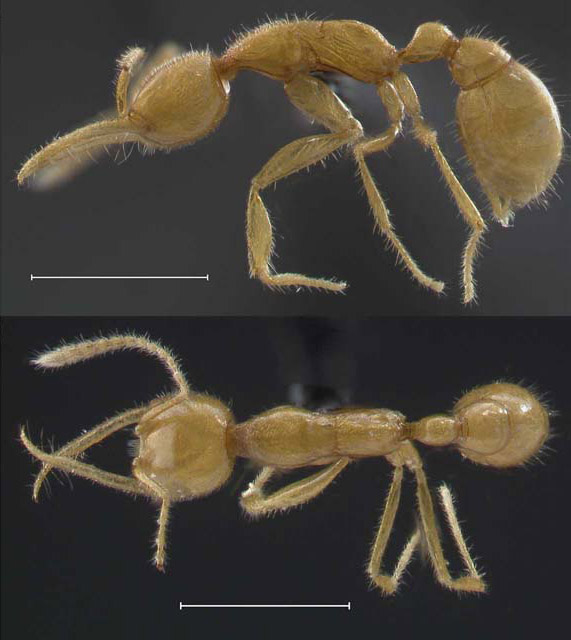
Newly discovered Subfamily Martialinae (Rabeling & Verhaagh 2008)
A new species of blind, subterranean, predatory ant, Martialis heureka, was discovered in the Amazon by Christian Rabeling (The University of Texas, Austin) and Manfred Verhaagh (Staatliches Museum für Naturkunde Karlsruhe) in the leaf litter of the Amazon rainforest near Manaus, Brasil. It belongs to the first new subfamily of living ants discovered since 1923, the Martialinae Rabeling & Verhaagh 2008, and is a descendant of one of the first ant lineages to evolve over 120 million years ago.
DNA sequence data of Martialis heureka were added to the previously published data from Brady et al. (2006) and place Martialis as sister to the remaining extant ants and support the monophyly of all ants, including Martialis. Here we present the first automontage pictures of Martialis heureka photographed by C. Rabeling & M. Verhaagh (Credit: National Academy of Sciences, PNAS © 2008). Our hearty congratulations go to the lucky researchers that are here shown in their Amazonian study area.
Christian Rabeling, Jeremy M. Brown and Manfred Verhaagh "Newly discovered sister lineage sheds light on early ant evolution" Proceedings of the National Academy of Science 2008
Taxonomic description of the new subfamily Martialinae Rabeling & Verhaagh, 2008
From: Christian Rabeling, Jeremy M. Brown and Manfred Verhaagh "Newly discovered sister lineage sheds light on early ant evolution" Proceedings of the National Academy of Science 2008 (online first http://www.pnas.org/content/early/2008/09/13/0806187105.abstract)
Worker diagnosis: small, blind, pale, presumably subterranean ants with the following combination of characters. Putative apomorphic conditions are marked by an asterisk. (1) Prementum partly visible with closed mouthparts, not entirely concealed behind the broad labrum and stipites; (2*) clypeus highly reduced; (3*) eyes absent; (4) frontal lobes absent; (5*) antennal sockets fully exposed and distant from each other, positioned at anterior margin of clypeus and projecting anteriorly beyond it; (6*) toruli raised vertically, forming cups to hold condylar bulbs; (7) antennae 12 segmented; (8) promesonotal suture present and flexible; (9) propodeal lobes absent; (10) metapleural gland orifice slit shaped, dorsal orifice margin projecting slightly forward, but not overhanging or concealing opening; (11*) metacoxal cavity closed, with a complete cuticular annulus surrounding the cavity; (12) metasternal process absent; (13*) petiole tergosternally fused, without a trace of a suture between tergite and sternite; (14*) abdominal segment III broadly attached to segment IV but distinctly smaller than the latter, tergosternally fused; (15) helcial tergite well developed, posterior part with a girdling constriction; (16) abdominal segment IV not tergosternally fused, posttergite broadly overlapping abdominal segment V; (17) stridulitrum on presclerite of abdominal segment IV absent; (18) spiracles of abdominal segments I-IV exposed, of V-VII concealed by preceding postsclerites; (19) pygidium (tergite of abdominal segment VII) well developed, simple, neither armed with teeth or setae nor heavily sclerotized nor otherwise modified; (20) sting present; (21) metatibial gland absent; (22) tarsal claws simple, without preapical teeth.
Queen, male, and larva are unknown.
Only known genus: Martialis Rabeling & Verhaagh, gen. nov.
Type and only known species: Martialis heureka Rabeling & Verhaagh, sp. nov.
©2008. Martin Pfeiffer. University of Ulm.
Antbase.net is designed and maintained by Martin Pfeiffer & Hans Peter Katzmann, Department of
Experimental Ecology







